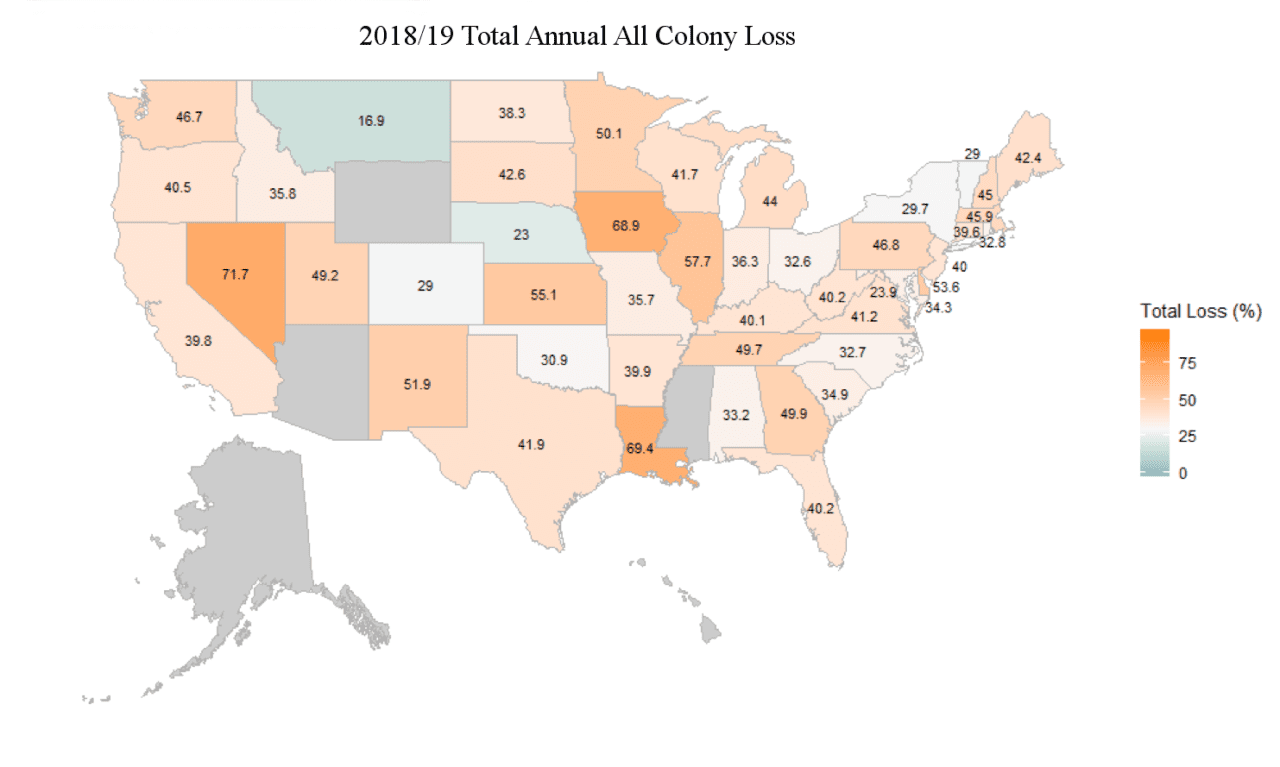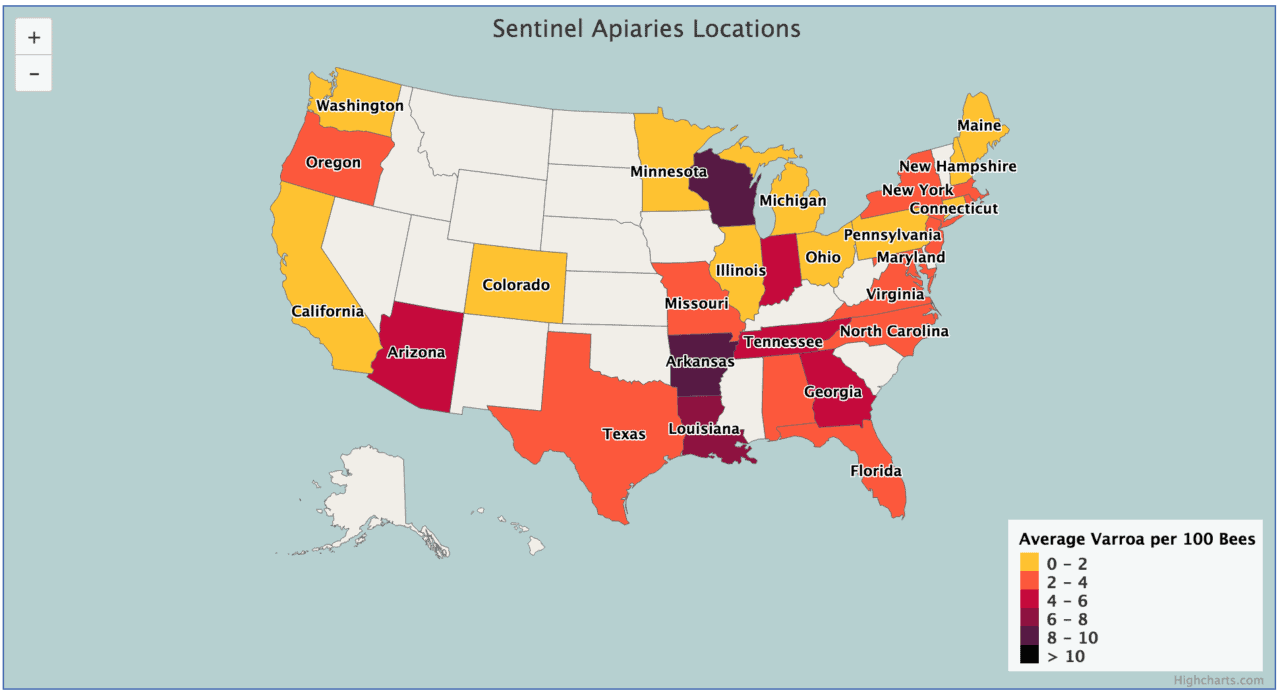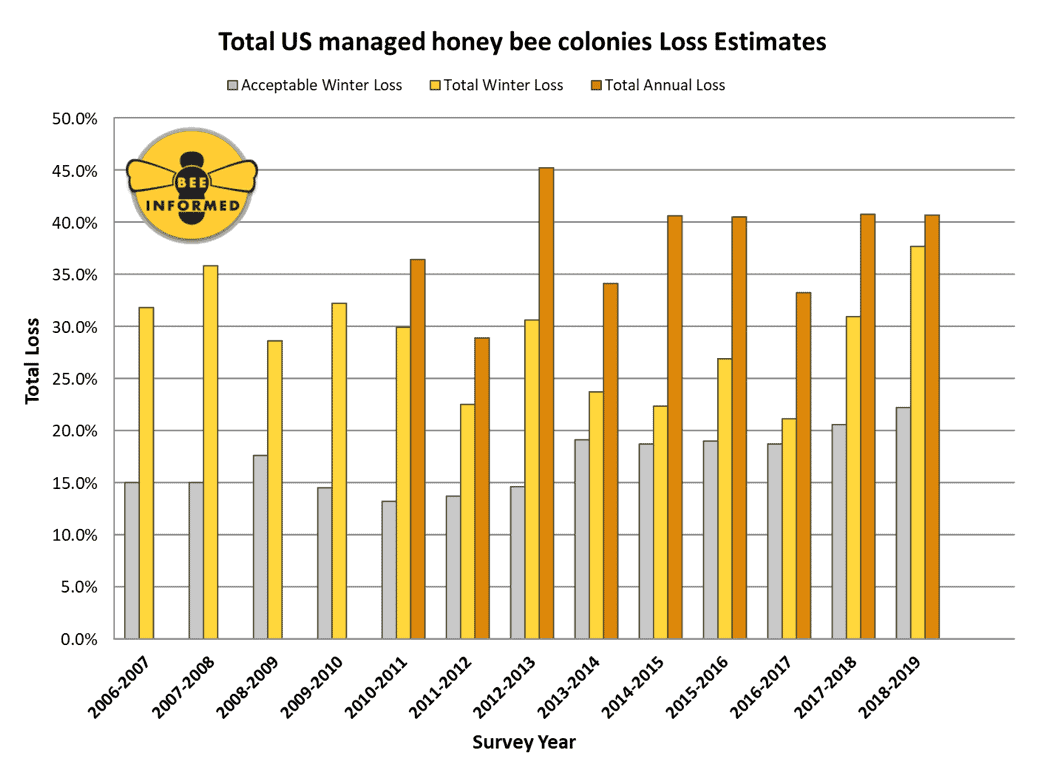Happy Fall y’all! In normal life, “Fall” means Halloween (and dressing up as fatbody-sucking Varroa mite) and Thanksgiving (we certainly are grateful to be part of the beekeeper community). In beekeeping life, “Fall” means that nectar flows come to an end, queens lay fewer eggs, winter bees are being reared and we have to (still) deal with Varroa mites. All this is happening for a reason: To get the bees ready for and successfully bring them through winter. (Hard to believe here in Alabama where it is still blazing hot!) You may remember that we reported the highest honey bee colony winter losses since the…
Category: Blog
The Bee Informed Blog is the place where team members convey their experience, knowledge, and opinions about their work with bees. Here is your opportunity to follow what’s happening in the field and lab.
Sentinel Apiary Program Monthly Memo: October Issue
Welcome back to yet another Sentinel Apiaries update. We’re coming to you in the spookiest month of the year with some pretty scary stuff: mites, mites and more mites! I spent an embarrassing amount of time in photoshop to drive this point home (see right). As we always do in September, we saw a pretty significant jump in mite loads last month. Over 50% of states were above treatment threshold. You can see a lot less yellow (below threshold states) on our Varroa heat map below. Mite loads in Sentinel apiaries were much higher this September than last year (see below). If you have yet…
Sentinel Apiary Program Monthly Memo: September Issue
Hello Beekeepers, we’re back with the September Sentinel Apiary update one day late but hopefully not a dollar short! It’s been a very busy month full of monitoring and treating for mites, plus a trip to Montreal for the Apimondia world beekeeping conference. It was such a blast to see so many Sentinel beekeepers and BIP supporters north of the border and to present the program at the citizen science session. Of course, while the beekeeper is away, the bees (and mites) will play. Here’s what happened with Sentinel Apiaries in August (September update to come shortly). Last month, 61 beekeepers submitted 330 samples…
The NEW Honey Bee Discovery Center in Orland
A few weeks ago, I was invited to the Honey Bee Discovery Center Kick-off and Exhibit Preview in Orland, California. This event was followed by the Queen Bee Festival the day after. The Honey Bee Discovery Center is ‘the first interactive exhibit and museum of its kind’. It highlights the history of beekeeping from hobbyists, sideliners and commercial operators’ perspectives, and features the evolution and breakthroughs in equipment, pollination and art inspired by bees. Inside the center, one can find multiple showcases of vintage bee equipment related to all apicultural activities, complete with an observation hive near the center of the room. All around the new…
New BIP Team Perspective
Forward: For my first blog post I was asked to write about my perspective of joining BIP as a tech transfer team member. I have been in the field so much that I am just now getting around to it. I hope this blog accurately captures both the factual and emotional aspects of becoming a BIP tech team member. So here it goes... It’s About The Bees! As one of the rookies on the Bee Informed Partnership (BIP) tech transfer team, I feel incredibly lucky to have joined BIP at such an interesting time for the organization, and for the beekeeping industry itself. On the first…
Sentinel Apiary Monthly Memo: August Issue
We’re back again with another monthly update from the Sentinel Apiary Program! Let’s take a look at what’s been going on with mites, drones, honey, and more over the past month. Throughout the month of July, Sentinel participants submitted 378 samples from 71 apiaries across 27 states! July finally showed us a big increase in mite loads, with the average Sentinel apiary now at the treatment threshold of 3 mites/100 bees. This July Sentinel apiary mite loads are higher than the historic national average, and much higher than the mite loads from last year’s Sentinel apiaries. This could mean we’re having especially high Varroa pressure…
Sentinel Apiary Monthly Memo: July Issue
We’re here to help you beat the heat with your second monthly Sentinel Monthly Memo of the year. It has been hotter than Hades out there, so hopefully you and your bees are keeping cool. We’re another month into the 2019 Sentinel Apiary Program, and here’s what we’re seeing. In the month of June, we received a record 417 samples from 70 Sentinel Apiaries in 28 states. To put that into perspective, that’s over 125,000 bees, enough to comprise 2-3 full colonies. Our undergraduate lab technicians are certainly being put to good use! Congratulations to the state with the lowest June mite load: New Hampshire…
Donate to BIP when you shop at Amazon!
Today and tomorrow are Amazon Prime shopping days and if you have been waiting to purchase those early (or late) Christmas presents or treat yourself to some much needed items, it is easy to make supporting the Bee Informed Partnership part of all your Amazon shopping. Through Amazon Smile, you can build in a small donation to BIP every time you shop at no additional cost to yourself. With each purchase on Amazon Smile, 0.5% of the sale to a will go to an organization of your choice, and we hope that The Bee Informed Partnership is your non-profit of choice! To add BIP as…
Empty Calories
Somewhere early on in a “Beekeeping 101” class you’ll learn that honey bees forage for 4 things: nectar, pollen, propolis, and water. The nectar and pollen become honey and bee bread to provide sustenance. Propolis is used as a structural component and also contributes to colony health through immunological activity. Previous blog posts about propolis here and here provide more information. Water is necessary for a variety of purposes including preparation of brood food and evaporative cooling. So in addition to water, bees need 3 substances produced by plants. But do they collect anything else? Of course they do. If you’ve ever seen open syrup…
Latest Loss Survey Results 2018-2019
Dear BIP Survey participants, You might have been wondering when the preliminary results of the 2018-2019 Bee Informed Partnership Colony Loss and Management Survey will be posted. Well, today is the day. Thanks for your patience! The “traditional” abstract is now posted on the BIP webpage here, while the Press Release issued by the University of Maryland can be read here. We want to thank all of you – whether you are a long-term respondent or a new-Bee to the survey – for participating this year. The information you provided is critical to building a long-term data set that we can now use to develop…


